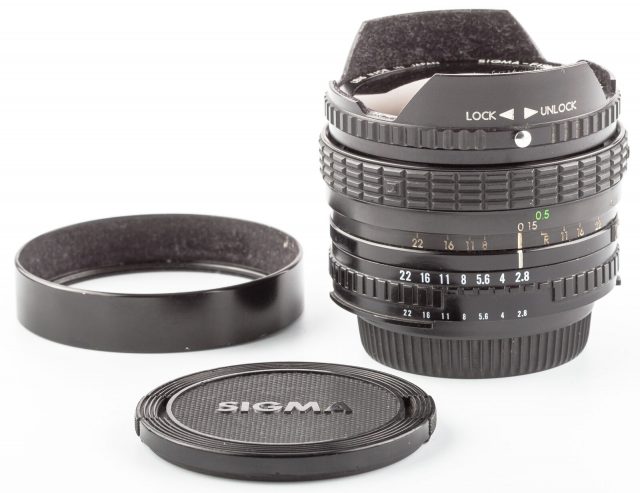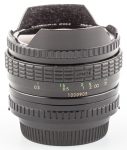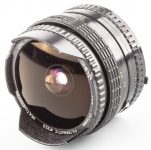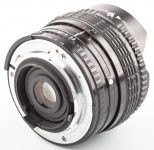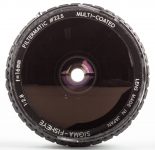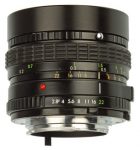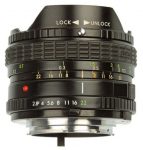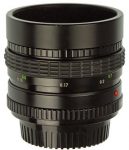Announced
Production status
Original name
Pros and cons
Genres or subjects of photography
Recommended slowest shutter speed when shooting static subjects handheld
Sigma MF 16mm F/2.8 Filtermatic Fisheye Multi-Coated
Fisheye lens • Film era • Discontinued
Abbreviations
| FISHEYE | An ultra-wide angle lens with strong uncorrected barrel distortion and extreme angle of view. |
| Multi-Coated | Multi-layer anti-reflection coating is applied to the surfaces of lens elements. This anti-reflection coating increases light transmission, eliminates flare and ghosting, and maintains color consistence among all lens models. |
Model history
| ■Sigma MF 16mm F/2.8 Filtermatic Fisheye Multi-Coated | A | 9 - 8 | 0.15m | -- | 1980 ● | |
| ■Sigma MF 15mm F/2.8 Fisheye Multi-Coated ZEN | A | 8 - 7 | 0.15m | -- | 1990 ● | |
Specification


| Optical design: | |
| 16mm | |
| F/2.8 | |
| 35mm full frame | |
| Canon FD [42mm] | |
| Contax/Yashica [45.5mm] | |
| Fujica X [43.5mm] | |
| Konica AR [40.5mm] | |
| M42 [45.5mm] | |
| Minolta SR [43.5mm] | |
| Nikon F [46.5mm] | |
| Olympus OM [46mm] | |
| Pentax K [45.5mm] | |
| Rollei QBM [44.46mm] | |
| 180° | |
| 9 elements in 8 groups | |
| Diagonal (full-frame) fisheye | |
| Diaphragm mechanism: | |
Diaphragm type: | Automatic |
Aperture control: | Aperture ring (with or without Auto Exposure setting) |
| 6 (six) | |
| Focusing: | |
| 0.15m | |
| <No data> | |
Focusing modes: | Manual focus only |
Manual focus control: | Focusing ring |
| Physical characteristics: | |
| 305g (Pentax K) | |
| ⌀66×50mm (Pentax K) | |
| Accessories: | |
| Removable front filters are not accepted | |
| Built-in petal-shaped | |
| <No data> |
Source of data
- Manufacturer's technical data.
Manufacturer description #1
While the Circular Image Fish-Eye gives you a circular image picture, this 16mm Fish-Eye gives you a full frame picture of its 180 degree angle of coverage. With this Fish-Eye lens you can create special effects and because its unique design creates less distortion, you can use it just as you would use an ordinary lens. Featuring an amazingly bright f2.8 aperture, it is very compact, and offers the same easy, bayonet lock filter change system as the 8mm Fish-Eye lens.
Manufacturer description #2
180 degrees of full frame fisheye effects. Brilliant corner-to-corner, even in low light.
Magic, almost surreal panoramas, covering an incredible 180 degrees, filling the full 35mm frame with dramatic, never before achieved perspectives. The lens is the Sigma 16mm fisheye, and putting it on your camera is like inventing a whole new kind of photography!
Depth that's endless
Looking through a full-frame fisheye is a new experience. Horizons are curved, nearby objects are huge, distant ones tiny. With everything, from near to far, in sharp focus. And you can focus down to just 5.9", for even more startling effects.
Speed and quality too
Many fisheye lenses are extemely slow, and produce images that are round, or with poor corner resolution. Not the Sigma 16mm. It has a fast f/2.8 speed, so you can shoot even in dim light. It's sharp, right out to the corners. And Sigma's unique sculptured lens hood helps prevent flare and reflections.
Small in size and cost
It used to be that fisheyes were big and heavy, with prices to match, and required special oversized filters. But the Sigma 16 accepts standard 22.5mm filters, inserted right in the lens by way of a unique internal bayonet mount system. And four filters are included. The Sigma 16mm fisheye. Compact and light enough for any camera bag. And amazingly affordable, too!
Manufacturer description #3
Shooting with a fisheye lens with the mobility of a standard lens.
Sigma's 16mm lens is a very compact, bright f2.8 aperture full frame diagonal fisheye lens. With a 180 degree angle-of-view that captures the entire scene around you. And as a special technique facilitated by the broad depth-of-field one can even shoot without using the viewfinder.
The lens construction is a simplified 9 elements, 8 groups and provides good contrast and corner to corner image sharpness. Sigma's built-in perfect hood protects against ghosting and flare. It employs a screw-in type filter system with bayonet lock lens separation. Filter size is 22.5mm with four filters included as standard equipment.
Manufacturer description #4
Sigma's innovative design opens a whole new category of creative applications with this full frame fisheye lens. Its super fast f/2.8 maximum aperture now makes it possible to create extreme perspective compression effects in available light situations. And this larger aperture means brighter, faster, more accurate full frame focusing, too. Sigma also reduced minimum focusing distance to just 5.9", further enhancing the power of this fisheye to deliver dramatic effects.
The optical design of the new Sigma 16mm lens corrects the image problems inherent in many fisheye lenses. Problems such as poor corner resolution and loss of contrast at low f/stops. Computer-controlled multi-layer coating assures optimum light transmission throughout the visible spectrum, with a minimum of flare or aberration. A new degree of image brilliance is also achieved by a lens that utilizes fewer elements.
Most super wide angle lenses require oversized, add-on filters. The Sigma 16mm fisheye takes standard 22.5mm filters that slip easily into a special bayonet type release mount within the lens system itself. Four filters: Normal, Y-52, O-56, R-60 are included with the lens at no additional cost and mean added economy as well as added convenience. And an innovative "Perfect Hood" sunshade has been designed into the Sigma 16mm Fisheye to permit shooting at an angle 20 degrees closer to the sun without fear of flaring.
From the Modern Photography magazine (July 1981)
Sigma was one of the first independent lens makers to offer flexible filter holding arrangements for their wide-angle optics. The Filtermatic series pioneered the use of built-in filter turrets in reasonably-priced extreme-wide-angle lenses. With the new 16mm f/2.8 Filtermatic, they've bridged the gap between the convenient and inexpensive, yet unavoidably limited, filter range that could be permanently mounted in a turret, and the full line of conventional filters available for external mounting. The large diameter and wide field of view of ultra-wides and fisheye lenses makes the use of external filters almost impossible. The whole front of the new Filtermatic bayonets off in a trice, exposing a tiny 20.5mm screw-in filter for easy interchange. With the lens you get a set of four - normal (UV), R60 red, O56 orange and Y52 yellow tucked away neatly in the top of the lens case. Most importantly, almost any filter your heart desires can be ordered from independent filter manufacturers including Tiffen, Hoya and Kenko. Seems that 20.5mm screw-ins are a standard item so you can choose from the whole spectrum of color-correction, black-and-white and CC flters (from Tiffen).
LENS-DB: 20.5mm is a typo: the lens actually uses 22.5mm screw-in filters.
As it stands, the Sigma 16 is a fast, compact, easy handling semi-fisheye - a lens which covers the whole 24 x 36mm format, but with increasing barrel distortion toward the ends of the frame. The diagonal coverage is 180°. With the circular image adapter, a circular image is produced. In other words, you can get either the circular effect of the true 180° fisheye (but not the full field) or the conventional full-format rectangle with one optic.
The lens is compact, considering its high speed and super-wide angle of view. Generous 10mm textured rubber focusing collars and 6mm aperture collars, click-stops at half-stop intervals, and a built-in cutaway shade provide an easy handling package. A short 45° turn disengages the front optical groups, providing easy access to the filter. Locking is solid but provided by a ball-detent, not a latching mechanism. This makes it very easy to remove, but you should make sure that it is turned fully to the stop when replacing it to avoid rude suprises when focusing furiously or changing lenses. Quality of the internal bayonet seems high, so lens element alignment should hold up with frequent filter exchanges.
Close focusing to 6 in. and apertures to f/22 (and great depth of field, typical of wide angles), add up to dramatic close-up possibilities as well as all-encompassing curvalinear wide-angle photography.
Typical characteristics of fisheye lenses
- Extreme angle of view (at least 180° diagonally);
- Circular types (the image circle of the lens is inscribed in the image frame) or diagonal types (cover the entire image frame);
- Usually of equidistant projection type, with the distance from the picture center to any given point always proportional to the angle from the optical axis to that point;
- Huge barrel distortion;
- Short closest focusing distance (0.20 - 0.30m with 35mm full-frame prime lenses);
- Very large depth of field, eliminating the need for autofocus or precise manual focusing;
- Due to the extreme angle of view and convex front element, front filters cannot be used;
- Often equipped with a filter turret with swivel-mounted filters;
- Often come with a small, built-in petal-shaped lens hood.
From the editor
The number of elements and groups is indicated taking into account the filter.
The lens was also produced for the Ricoh K system under the name RICOH XR RIKENON FISHEYE 1:2.8 16mm.
